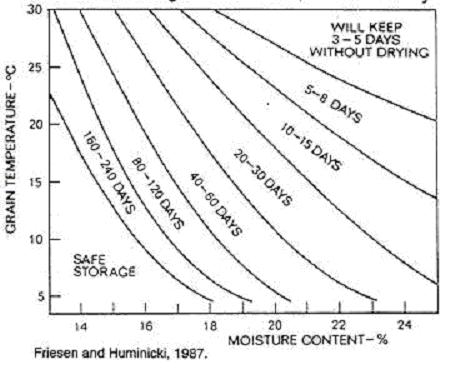| |
Grain Storage - Frequently Asked Questions | |
| |
|
|
| |
|
|
| | How much drying will I get with aeration?
The primary purpose for aeration is to achieve or maintain a uniform grain temperature throughout the bin. Some drying can occur in aeration systems, but generally, grain going into aeration bins should be within 1% of being dry enough for long term storage.
Should I turn my aeration off at night or during rainy days when the air is cool and humid?
Since aeration is a tool for managing grain temperatures, there is no need to turn off the aeration system at night or on cool days, even if it is humid. The benefit of this cool air for lowering the temperature of the grain greatly overshadows any negative effects of the small amount of moisture that is added to the bin.
How much moisture will grasshoppers add to grain in storage?
Grasshoppers in grain may look and smell like a problem, but it is unlikely that grasshoppers will add enough moisture to a bin to cause grain to go out of condition. The amount of moisture that grasshoppers add to grain can be estimated based on the average size of grasshoppers and assuming that they are about 70% moisture. The size and weight of grasshoppers varies with species and with gender but assuming average type weights for the pest species normally found in Alberta, it takes about 300-800 grasshoppers per bushel of barley or canola to raise the moisture content of this grain by 1%. In wheat and peas it takes 400-1000 grasshoppers per bushel to change the moisture content by the same 1%.
What is considered dry grain?
Maximum Moisture Content Levels for Straight Grade Seed*
| Barley (feed) | 14.8 |
| Barley (malt) | 13.5 |
| Canola | 10 |
| Chickpeas | 14 |
| Corn | 15.5 |
| Domestic Mustard Seed | 10 |
| Fababeans | 16 |
| Flax | 10 |
| Lentils | 14 |
| Oats | 14 |
| Peas | 16 |
| Rye | 14 |
| Soybean | 14 |
| Triticale | 14 |
| Wheat | 14.5 |
*percentage wet weight basis
(Adapted from: Cereal Grain Drying and Storage, A&F)
How long can I store my grain?
Storage time varies depending not only on moisture, but also the temperature of the grain.
- Canola: If storing longer than 5 months the moisture should be no higher than 8% with uniform temperatures of under 15 °C.
- Peas: For prolonged storage the moisture should be less than 14% moisture and be cooled to less than 15 °C.
- Cereals: For long-term storage at 14 % the temperature should be 20 °C or less.

Effect of Temperature and Moisture Content on Allowable Storage Time of Wheat, Oats, and Barley.
(Source: Cereal Grain Drying and Storage, A&F)
What is the maximum drying temperature for grains?
The high temperatures in grain dryers can damage the grain. The maximum allowable air temperatures for drying will depend on the crop in question and the end use of that crop. Note that the values given in the following table are air temperatures going into the dryer and are not the temperatures of the grain itself.
 | Seed | Commercial | Feed |
| Wheat | 60 °C | 65°C | 80-100°C |
| Oats | 50°C | 60°C | 80-100°C |
| Barley | 45°C | 55°C | 80-100°C |
| Flax | 45°C | 80°C | 80-100°C |
| Canola | 45°C | 82°C | --- |
| Peas | 40°C | --- | 45°C |
Management of Cereal Grain in Storage
Cereal Grain Drying and Storage
Storage of Canola
Prepared by Ag-Info Centre, Alberta Agriculture and Forestry |
|
| |
|
|
| |
For more information about the content of this document, contact Neil Whatley.
This document is maintained by Brenda McLellan.
This information published to the web on September 10, 2003.
Last Reviewed/Revised on January 30, 2017.
|
|